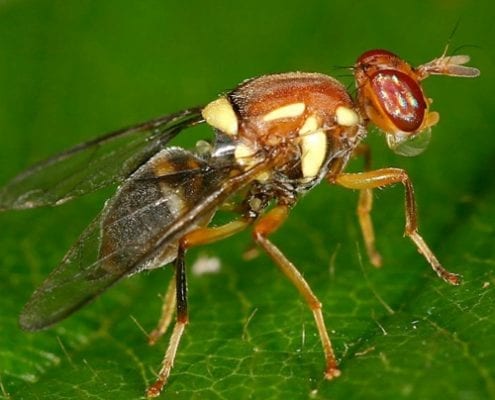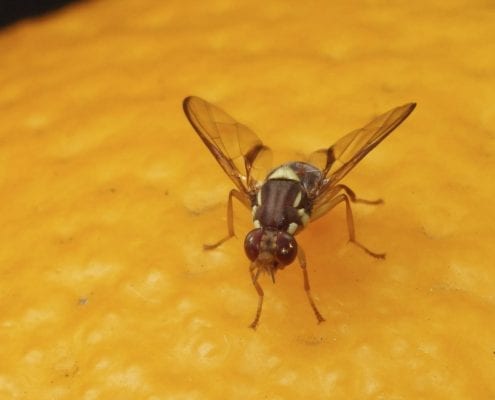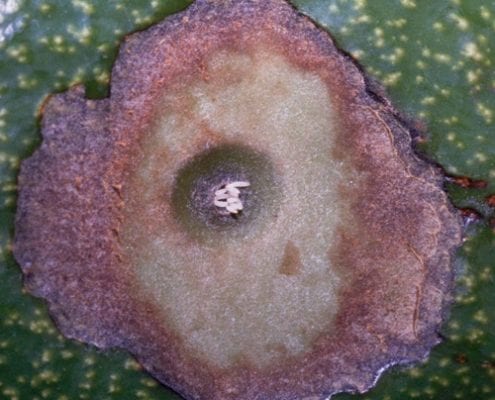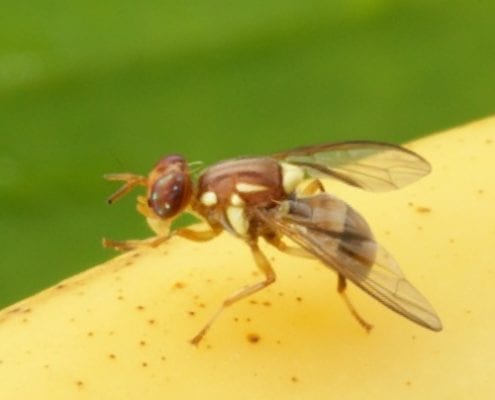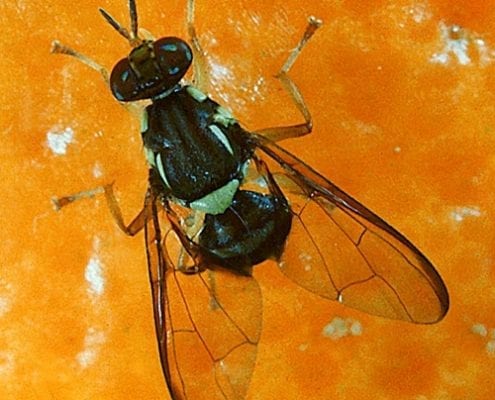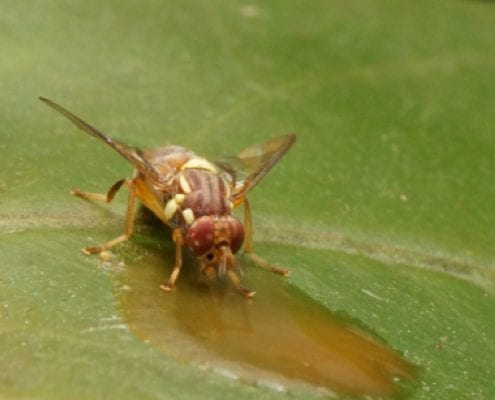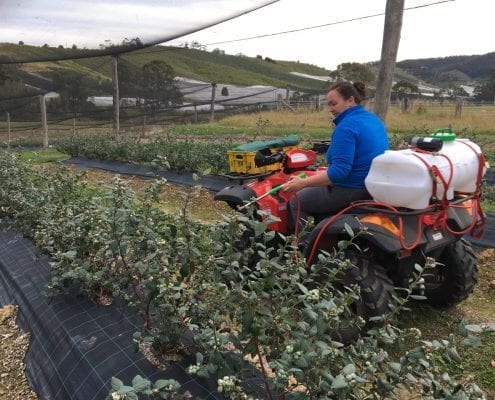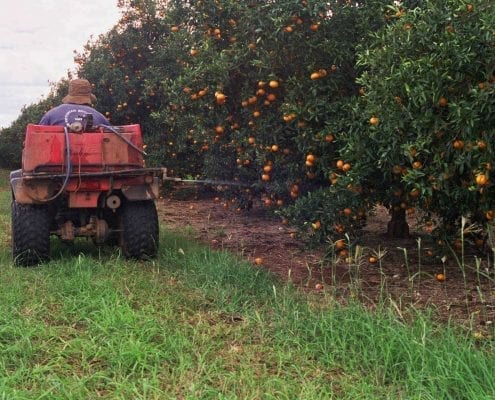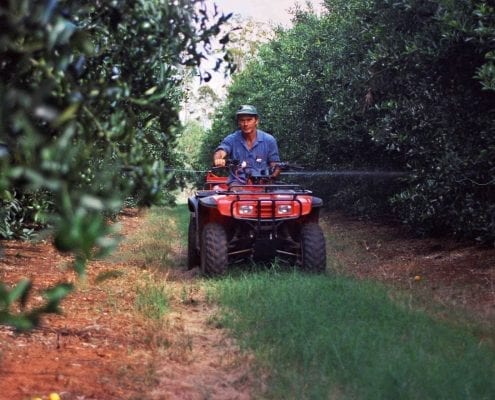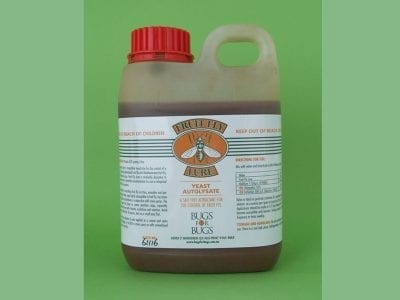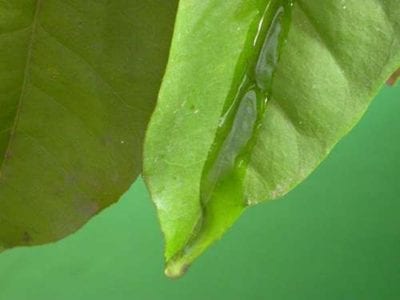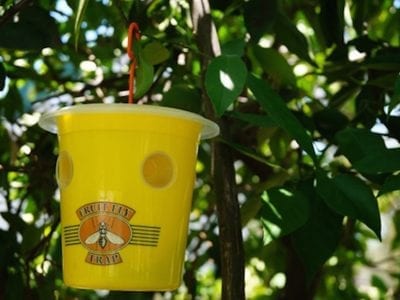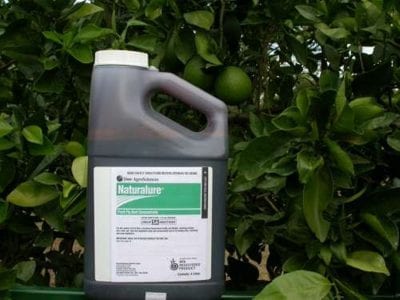Fruit flies
Overview
Fruit flies are some of the most significant pests of fruit and vegetables throughout the world. The fruit flies that cause damage in our orchards are known as tephritid flies. They are quite different to the drosophila group that many people will know as small brown flies that hang around decaying fruits in a fruit bowl. The drosophila flies are not agricultural pests and are mostly only a nuisance where fruit and vegetables are stored. Australia has very many tephritid fruit fly species but the most well known and damaging are Queensland fruit fly and Mediterranean fruit fly. Queensland fruit fly occurs in eastern Australia through much of Queensland, New South Wales and Victoria. Med fly is present in Western Australia.
In this article the term ‘fruit fly’ refers to Queensland fruit fly although management techniques are similar for most of the tephritid group.
Damage
Female fruit fly lay their eggs into healthy, ripening fruit on the tree. Queensland fruit fly has been recorded from a wide range of native and introduced fruits (around 250 species). Around 6 or more white banana shaped eggs are deposited just beneath the skin. A ‘sting’ mark usually appears on the surface of the fruit. It may be accompanied by a gum-like exudate. Fruit subsequently drop to the ground and very heavy losses can be incurred if control measures are not taken.
Life cycle
Eggs hatch in 1-2 days. The maggots commence feeding on the flesh of the fruit and a localised rot develops causing the fruit to drop to the ground. After a week or so mature maggots leave the fruit to pupate in the soil. Around 2 weeks later adult flies emerge to mate and resume the cycle.
Biology
To manage fruit fly in orchards there are several important things to understand about their biology:
- The female fruit fly must feed on a source of protein before her eggs will mature
- She must wait about 5 days before she can commence egg lay
- Adult flies usually mate and feed in the host tree
- They are strong fliers and can travel some distance
- The males of many species are strongly attracted to specific chemical compounds
- A female fruit fly only mates once in her lifetime
- Adult flies can survive winter but females will re-sorb their eggs during extended periods of cold weather
- Fruit fly threat is greatest while susceptible fruit are available, the weather is warm and conditions are moist
- Flies are most active from dawn for the first few hours of the day
- Continued availability of suitable host plants will favour fruit fly populations
Fruit fly management
Fruit fly is potentially a very serious threat and can cause extensive crop loss. It is also an important quarantine pest placing severe restrictions on fruit movement from areas where it occurs naturally. There are several strategies which, when combined and carried out diligently can provide excellent control of fruit fly in commercial or domestic crops.
You can find all the practical information that you need to implement a systems approach to fruit fly management in the Bugs for Bugs Fruit Fly Toolkit.
Protein baits
Protein baits consist of a liquid protein that is then mixed with a toxicant. They must be applied regularly to the foliage or trunk of the host tree. Baits are susceptible to weathering and must be applied more frequently during periods of high rainfall.
Bait applications must commence before fruit fly establishes in the crop and regular treatments are essential for this method to succeed. Increased baiting frequency may be necessary during periods of high pressure from fruit fly. Thickeners can improve the life and efficacy of protein baits and are recommended during periods of high pressure.
An organically approved protein bait is now available (see Naturalure ™ Fruit Fly Bait below).
Male traps
Counting and recording fruit fly populations helps us understand fruit fly activity in an area, and we can use this information to fine tune control programs. Male traps contain a cotton wick impregnated with a powerful male sex attractant (cue lure), and an insecticide. These traps can be a useful monitoring tool but trap counts must be interpreted carefully. It is important to note that:
- These traps only catch male fruit flies
- The number of flies caught does not necessarily indicate the size of the population but can indicate population trends
- Fruit fly traps do not control fruit fly – you must use protein bait sprays also to achieve this
Female traps
Female traps are generally not very effective. Research is continuing into developing better female traps. They are usually of little value in commercial orchards but may be useful for domestic situations. Female traps require high maintenance and captured flies are difficult to identify.
Male annihilation technique (MAT)
MAT cups are designed to reduce the male fruit fly population. They contain the same impregnated cotton wick used in the male fly traps. Cups are placed at 10-20 per hectare 3 times per year. MAT cups are most effective when used over large areas or entire cropping regions. (Note that MAT cups compete with male fruit fly traps, affecting the results of traps set up for the purpose of monitoring.)
Cover sprays
Conventional insecticides may be applied to kill eggs and young larvae in the fruit. However currently registered insecticides are very toxic to beneficial insects and are not compatible with integrated pest management (IPM). Currently registered products are also under review and their continued availability is in doubt.
Cover sprays should only be used as a last resort if all other measures fail. Thorough coverage is essential.
Sterile Insect Technique (SIT)
The technique relies on releasing huge numbers of sterilised male flies in a geographic region to eradicate fly populations. It is only of use in geographically isolated or marginal areas. It is very expensive and usually carried out by governments.
Other strategies
- Removal or slashing/mulching of fallen fruit can reduce pressure
- Remove all fruit from trees when mature
- Remove second-crop fruit to reduce opportunities for fruit fly
- Removal of alternate hosts in an area can reduce opportunities for fruit fly to breed
Additional information
- Download the Bugs for Bugs Fruit Fly Toolkit produced in 2021 for practical tips on applying a systems approach to fruit fly management
- Download the Manage Queensland Fruit Fly brochure produced by Bugs for Bugs and New South Wales DPI in 2015.
- View the QLD Fruit Fly Host Check List for a comprehensive list of host plants susceptible to Queensland fruit fly
- Download our Fruit Fly Brochure for extra information to help you with your fruit fly control program.
Management tools
Fruit Fly Lure protein bait is highly attractive to Queensland and Mediterranean fruit flies. It is mixed with a toxicant to attract and kill adult fruit flies. It is recommended for use as part of a ‘systems approach’ which includes Fruit Fly Traps and the MAT cups.
Fruit Fly Lure Thickener is a food grade thickener added to the protein lure mix to improve weathering and longevity in the field.
MAT cups attract and kill male Queensland fruit flies. The cups contain a cotton wick impregnated with cue lure (a powerful male sex attractant) and madison (an insecticide). MAT cups are designed to be used in addition to Fruit Fly Lure protein bait sprays and Fruit Fly Traps as part of a systems approach to improved fruit fly management.
Fruit Fly Traps are used for monitoring the population of male Queensland fruit flies. They should be used in combination with Fruit Fly Lure protein bait sprays and MAT cups as part of a systems approach to controlling this pest.
Naturalure ™ is a protein and sugar based bait containing the active ingredient spinosad. The mixture is highly attractive to fruit flies, including Queensland and Mediterranean fruit flies. This product is included by the Biological Farmers of Australia (BFA) on the list of registered inputs suitable for use in Australian Certified Organic (ACO) farming systems.

